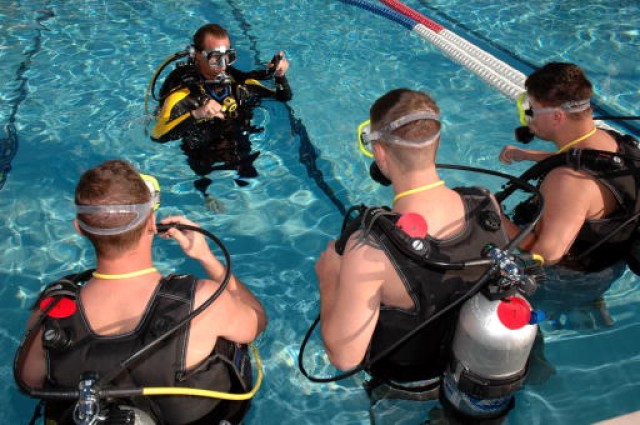Thursday afternoons, as the majority of the work force on Fort Belvoir is getting ready to head home, Army Management Staff College professor Addelier Guy heads to the pool, where he takes off his tie and puts on scuba gear. Guy is an instructor for the Soldiers Undertaking Disabled Scuba program (SUDS).
SUDS is a non-profit organization that trains and certifies wounded warriors in scuba diving. The goal of SUDS is to give veterans confidence. "Our clients are veterans who are receiving some form of physical rehabilitation. The majority are amputees," Guy said. "These are some tough kids," Guy said. "They are 19, 20, 21, and they have their whole lives still ahead of them.
Being a scuba instructor for wounded warriors has many rewards as well as challenges Guy said. "Some of the veterans have no muscle mass left. They complete things with pure will. Some of the wounded warriors have one leg and one arm missing, some have both legs missing. They have sheer determination to complete what they have to do. The hard part as an instructor is not to help them. I just tell them 'you have to do this.'"
To become certified, wounded warriors must be able to meet basic dive requirements and demonstrate their skills. "They go through about three or four pool sessions followed by a week-long open-water dive," Guy said. "There is an instructional text book session as well." Upon completion of the training, soldiers have six months to complete four open water dives for certification. "The dives occur in warm water because, most of the time, the veterans are not completely healed," Guy said.
To assist wounded warriors, SUDS has prosthetic swim legs, weight-integrated buoyancy compensators and webbed gloves. All of the equipment is donated, so the training, equipment and certification is free to the wounded warrior.
Bruce Gannaway was injured in December 2007 by an improvised explosive device while serving in Iraq as a company commander in the 3rd Infantry Division. His injuries included a laceration to his left foot and multiple broken bones in his left arm and hand that required the amputation of his left middle finger and a below-the-knee amputation.
"The great thing about being under water is that many of the physical issues are reduced," Gannaway wrote. "The fact I wear a prosthetic leg is not a hindrance once I'm under the water. I became a certified scuba diver in May 2008. I participated in a SUDS dive trip that took eight wounded warriors to Key Largo, Fla. We spent a week diving the reefs and wrecks in the local area and formed some close bonds with each other, the SUDS staff and the dive shop with whom we were working. Several wounded warriors on that trip have returned independently to Key Largo and continue to dive with the same dive shop."
"It's the most rewarding project I have ever been involved with," said John Thompson, president of SUDS. Thompson calls water the great equalizer. "Many things are just easier to do in the water with these type of injuries. It's part rehabilitation, part confidence building, part adventure for these wounded warriors."
More than 100 wounded warriors have gone through the program and are trained by volunteers at Walter Reed Army Medical Center who are headed by Larry Hammonds, Addeliar Guy and Lt. Col. Mark Berglund. A program at National Naval Medical Center Bethesda is run by Kevin Davenport, Jane Spencer and Titus Mott.
More information on SUDS is available from www.sudsdiving.org.


Social Sharing